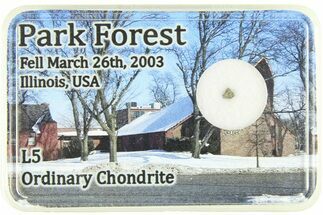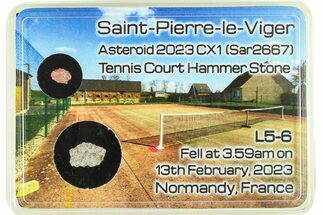This Specimen has been sold.
.12" Park Forest Meteorite Fragment - 2003 Illinois Witnessed Fall
This is a .12" wide (1.07 gram) fragment of the L5 chondrite known as Park Forest, which fell over the village of the same name in Illinois on March 26, 2003.
This specimen comes in its own labeled display case.
This specimen comes in its own labeled display case.
At nearly midnight on March 26, 2003, witnesses in Illinois, Indiana, and Ohio saw a bright fireball streak across the sky. Seconds later, the village of Park Forest in Cook County, Illinois was showered by numerous small stones: two houses were struck as well as the first station! Over the next few days, about 18 total kilograms of material were recovered, including a main mass of about 3 kilograms. The meteorite was dubbed Park Forest after its landing site.
Park Forest is an L5 ordinary chondrite with a brecciated texture. Some fragments display dark veins likely caused by impact melt, and many pieces are partially to fully fusion crusted. Chondrules are not usually present, but fragments often contain troilite and other metals.
Park Forest is an L5 ordinary chondrite with a brecciated texture. Some fragments display dark veins likely caused by impact melt, and many pieces are partially to fully fusion crusted. Chondrules are not usually present, but fragments often contain troilite and other metals.
About Chondrites
A chondrite is a stony (non-metallic) meteorite that has not been modified by either melting or differentiation of the parent body. Chondrites are formed when various types of dust and small grains in the early Solar System accreted to form primitive asteroids. Some such bodies are captured in the planet’s gravity well and pulled to the surface. They are by far the most common type of meteorite, representing about 86 percent of all meteorites that have fallen to Earth.
Prominent among the components present in chondrites are the enigmatic chondrules, millimeter-sized spherical objects that originated as freely floating, molten or partially molten droplets in space; most chondrules are rich in the silicate minerals olivine and pyroxene. Chondrites also contain particles of various metals such as nickel, iron, and aluminum. These formed at the very beginning of the solar system and aggregated over time: they are the oldest rocks known on Earth!
Chondrites are divided into about fifteen distinct groups on the basis of their mineralogy, bulk chemical composition, and oxygen isotope compositions. The various chondrite groups likely originated on separate asteroids or groups of related asteroids. Each chondrite group has a distinctive mixture of chondrules, refractory inclusions, matrix (dust), characteristic chondrule sizes, and other components. Other ways of classifying chondrites include weathering and shock. The L chondrite group is the most common of these.
A chondrite is a stony (non-metallic) meteorite that has not been modified by either melting or differentiation of the parent body. Chondrites are formed when various types of dust and small grains in the early Solar System accreted to form primitive asteroids. Some such bodies are captured in the planet’s gravity well and pulled to the surface. They are by far the most common type of meteorite, representing about 86 percent of all meteorites that have fallen to Earth.
Prominent among the components present in chondrites are the enigmatic chondrules, millimeter-sized spherical objects that originated as freely floating, molten or partially molten droplets in space; most chondrules are rich in the silicate minerals olivine and pyroxene. Chondrites also contain particles of various metals such as nickel, iron, and aluminum. These formed at the very beginning of the solar system and aggregated over time: they are the oldest rocks known on Earth!
Chondrites are divided into about fifteen distinct groups on the basis of their mineralogy, bulk chemical composition, and oxygen isotope compositions. The various chondrite groups likely originated on separate asteroids or groups of related asteroids. Each chondrite group has a distinctive mixture of chondrules, refractory inclusions, matrix (dust), characteristic chondrule sizes, and other components. Other ways of classifying chondrites include weathering and shock. The L chondrite group is the most common of these.
TYPE
L5 Chondrite
LOCATION
Park Forest, Illinois
SIZE
.12" wide
CATEGORY
ITEM
#285535
 Reviews
Reviews












